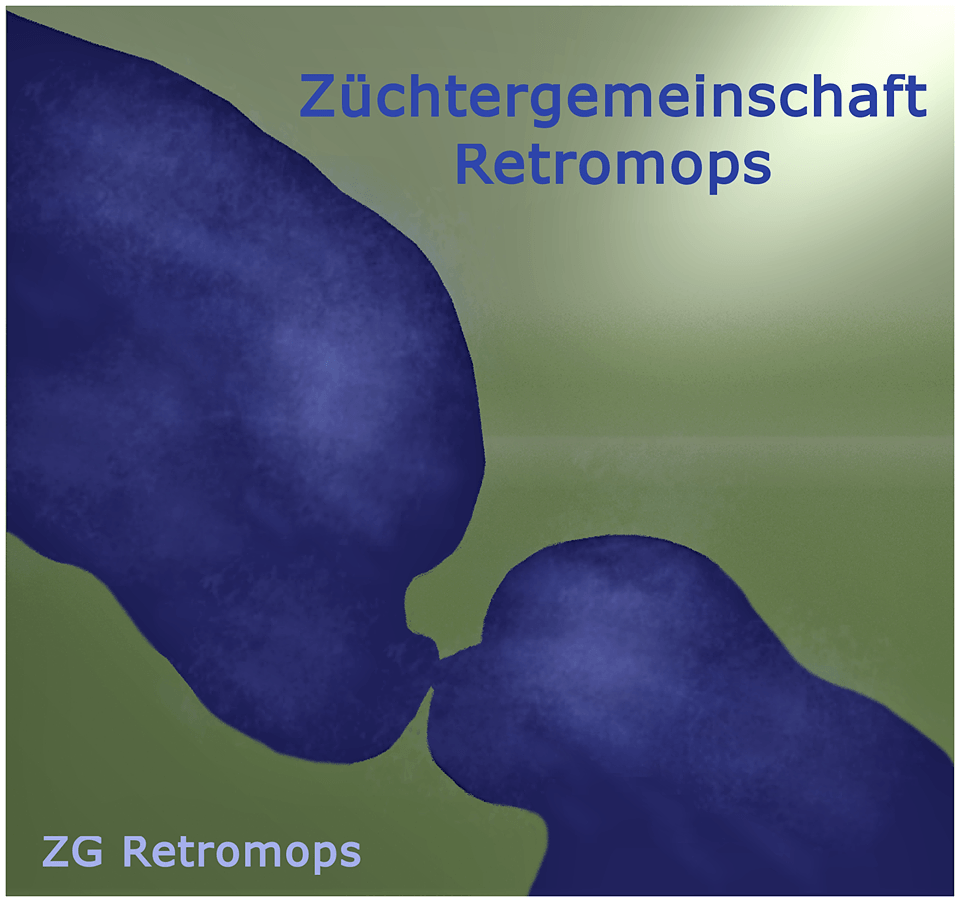ZG Retromops Zucht
Vom Alten Backofen
DEFAULT
THE OFFICIAL BREEDING STANDARDDES ZG RETROMOPSES
size: Shoulder height between 32 and 38 cm
Weight: 8 - 12 kg
body: Straight, broad, not too short back, deep, strong chest, tummy line drawn up.
hide: Short, smooth and shiny. The connective tissue should not be too loose; excessive wrinkling undesirable.
colour: All shades of beige, silver gray, spotted or brindle - ears and mask, nails and eel streak as dark as possible. Also completely black and animals.
(For detailed color description see below: "the colors of the retromops")
head: Short, blunt, as square as possible snout, never depressed. Smallest possible nasal fold. Straight bridge of nose with clearly open nostrils in the nasal sponge. Forehead lines in a darker shade.
jaw: Wide and strong. The lower jaw runs in a wide arc and ends in front of the upper jaw. When the muzzle is closed, the protrusion of the lower jaw (bite) is mitigated by means of the curve of the lower jaw branches. This is essential to prevent the lower jaw from protruding too much.
teeth: The incisors of the lower jaw should never be behind the upper incisors. The lower dental arch is rounded. The jaws must not be laterally displaced or twisted. The distance between the upper and lower incisor arches cannot be strictly defined - but with the muzzle closed, the upper and lower lips should meet in such a way that they completely cover the teeth.
Ears: Relatively small, falling forward, button or rose ear.
eyes: Well embedded in the facial skull, rounded to oval in shape. No exophthalmos. All shades of brown from amber to deep brown.
rod: Striped tail, if possible doubled and narrow-ended.
neck: not too short, no excessive dew formation.
Runs: Strong, well placed under the body with good ground clearance, black nails.
All in all
the dog should convey the powerful but elegant overall impression of a happy, small companion dog.
The Retromops is an alert, extremely intelligent and happy little companion dog, which always strives to please its people.
Although the retro pug is anything but a sleeping pill, its temperament is absolutely adjustable.
His hunting instinct is hardly pronounced and can be well contained by a little upbringing and training.
This makes it a real “all-rounder” - just as suitable for city life as it is for country life.
If you are interested, you can view the official FCI standard of the pug here:
FCI Standard 253 - Pug
COLORS OF THE ZG RETROMOPS
THE RETROMOPS WORLD IS COLORFUL!
By breeding foreign breeds we get a broader genetic diversity in our animals, which is also expressed in the color of the fur. We differentiate between the following colors:
BEIGE
Beige is always a mixed color. It denotes a very light brown, which can play in the warm reddish, yellowish (up to almost white) and cooler gray.
fawn
: Warm beige tones (fawn, apricot, sand, up to isabel tones) with individual, scattered black hair
sable
: fawn with a lot of scattered black hair, evenly distributed
silver
: Cooler silver-beige tones (mask and eel stroke are often particularly impressive in these animals)
wolf-sable
: Wild colors with the basic color fawn or silver, whereby the individual hairs are banded.
With some puppies there is only a small difference between wolf-sable and sable and it may well be that a supposed wolf brightens up to sable until it is an adult. Sable, on the other hand, can brighten up to a clear fawn in adulthood.
BLACK
black lacquer without undertone, or with brownish or silver brightening.
Silver gray
: genetically black dogs that lighten the silvery-beige color, but show a black head and saddle, often with runs darkening towards the paw. Black in particular is often difficult to assess and it may be that the respective tone only develops as it grows.
FLOW
Brindle
: black with beige flame
Reversebrindle
: looks like flamed beige black
The current is always fawn (all shades of beige from fawn to silver), the wider the current (flame), the more the impression increases that the dog would have been black flamed - that's why, from a certain appearance, it is said that the dog would have been brindle in reverse, so reverse brindle.
Some dogs are exactly between the two variants and are often called Tigerbrindle with this exterior.
CHECK
Piebald
: Pied animals are often described as a "white dog with colored spots" - it is actually the other way around. The primary color of the dog cannot develop due to the check gene in certain places, where the fur is white.
For this reason, pied animals are sometimes only provided with a small white spot (minimal check) - and sometimes almost the entire animal can appear as white (extreme check). In principle, however, they wear the color that they show outside of this check.
In dogs with very little white (minimal spotting - mostly on paws, chest, possibly front line) only the basic color is given.
Ticking
(Mold):
The retro pug, which carries both the Parson Russell (with permitted ticking) and - through the color pug breeding - the French Bulldog (with disqualifying ticking there) in its genome, can show a more or less pronounced ticking. The ticking usually only shows up in the color of the dog's basic color at around three weeks of age, but only on white areas.
In the case of pied retro pegs and those with so-called ticking, however, health aspects must also be taken into account. You can find more information here:
Check
You can find more information on color genetics on the website of graduate biologist Susanne Linksteding:
The text was written by Birtgit Schröder - ZG Retromops breed from Johannisberg
-
We thank Ms. Schröder for permission to use this text.



